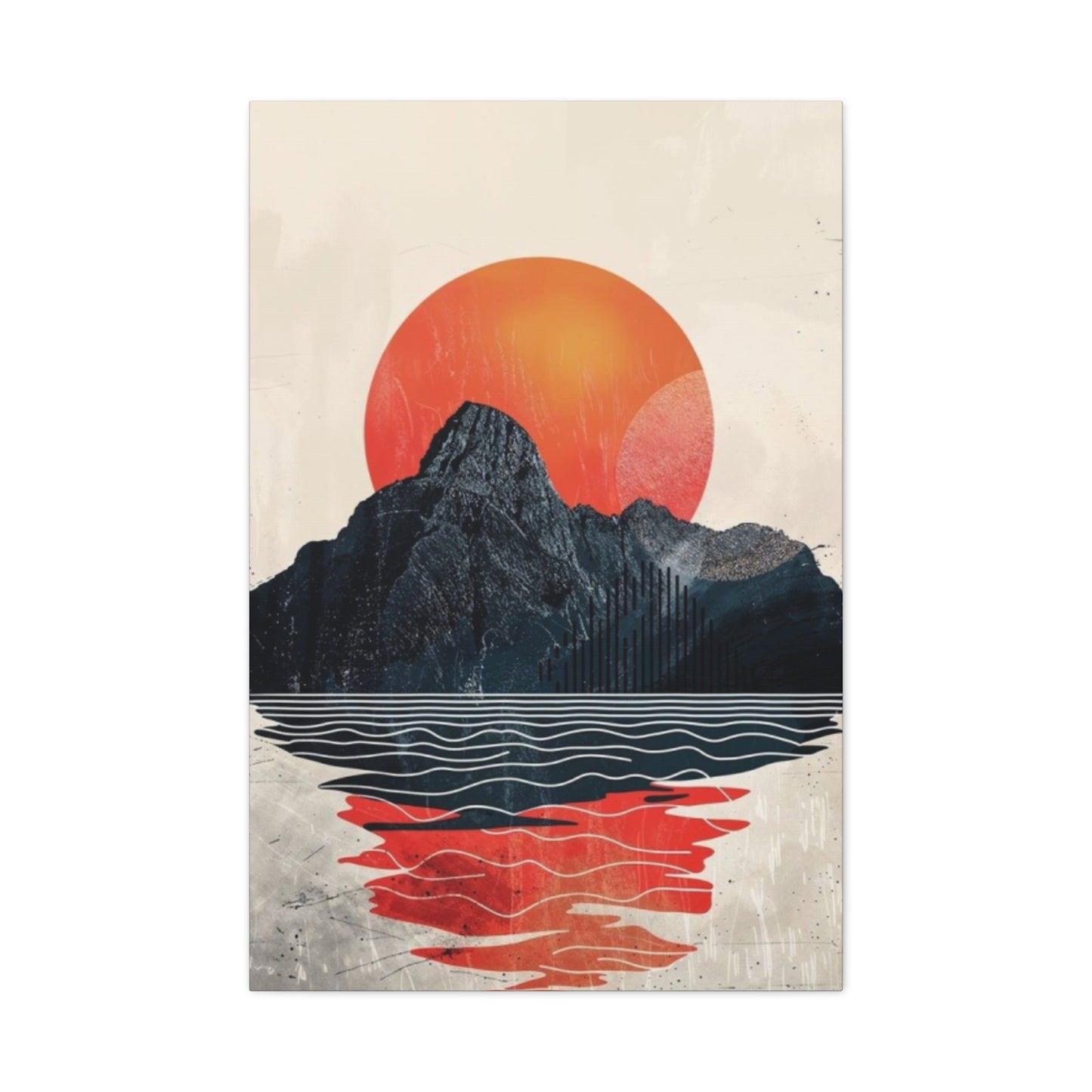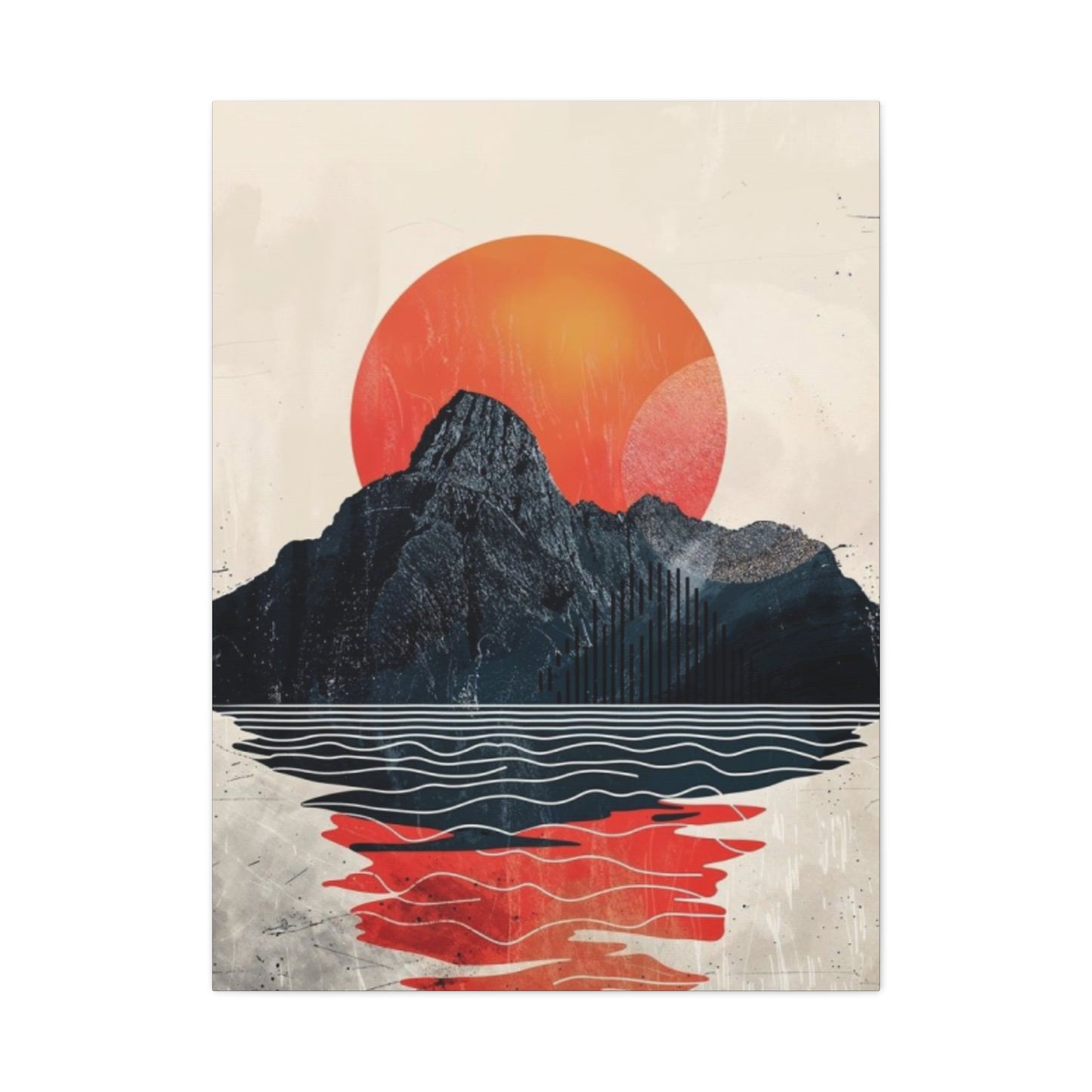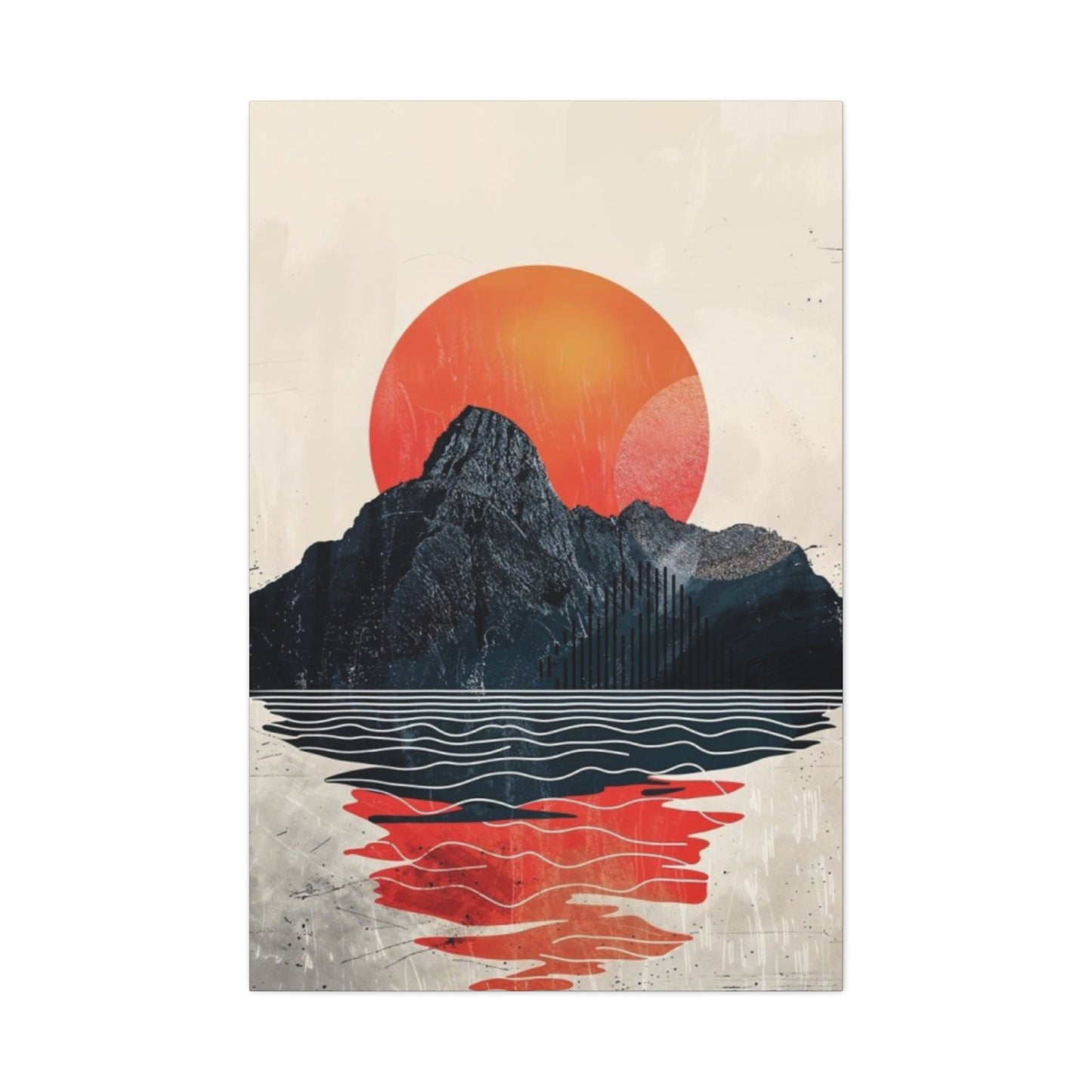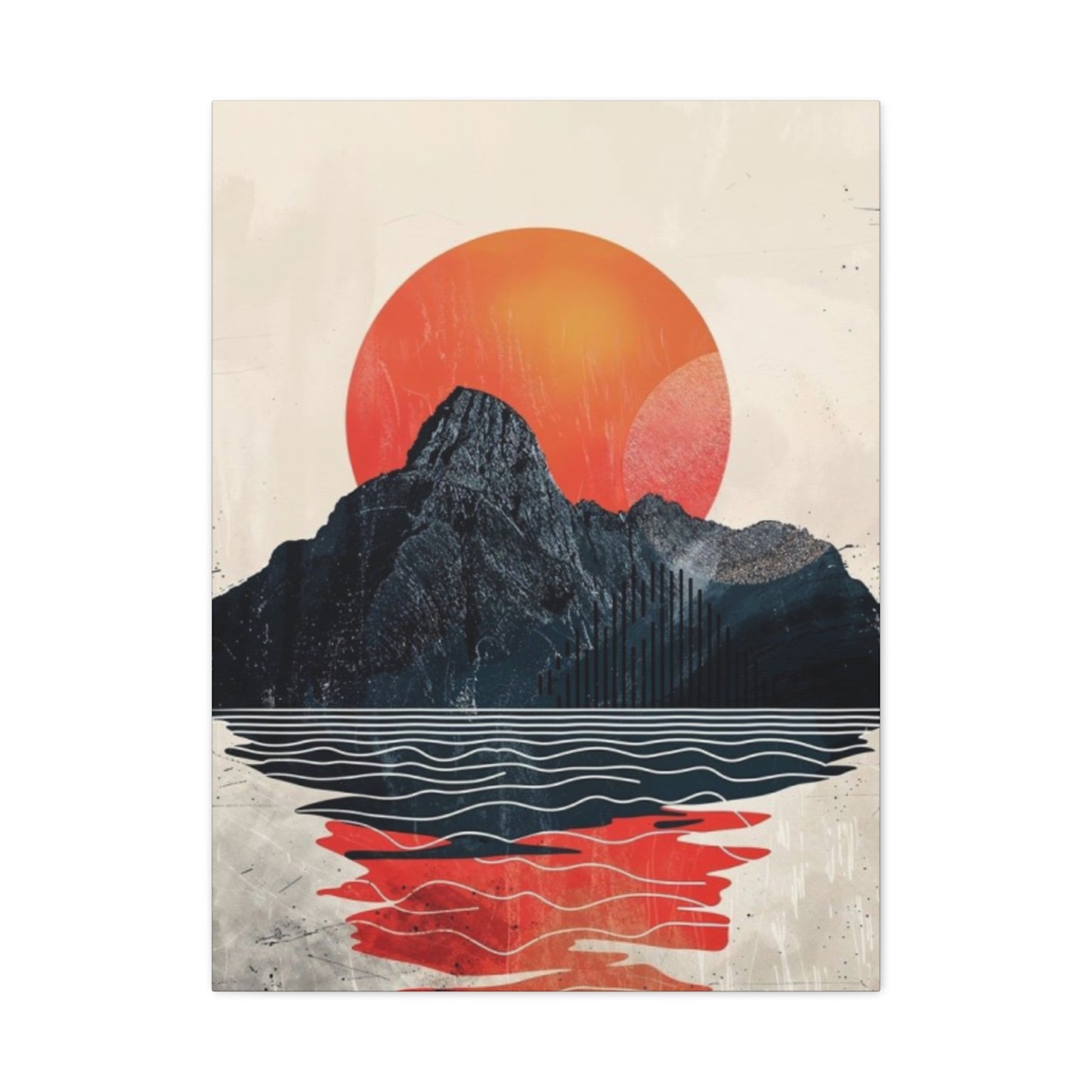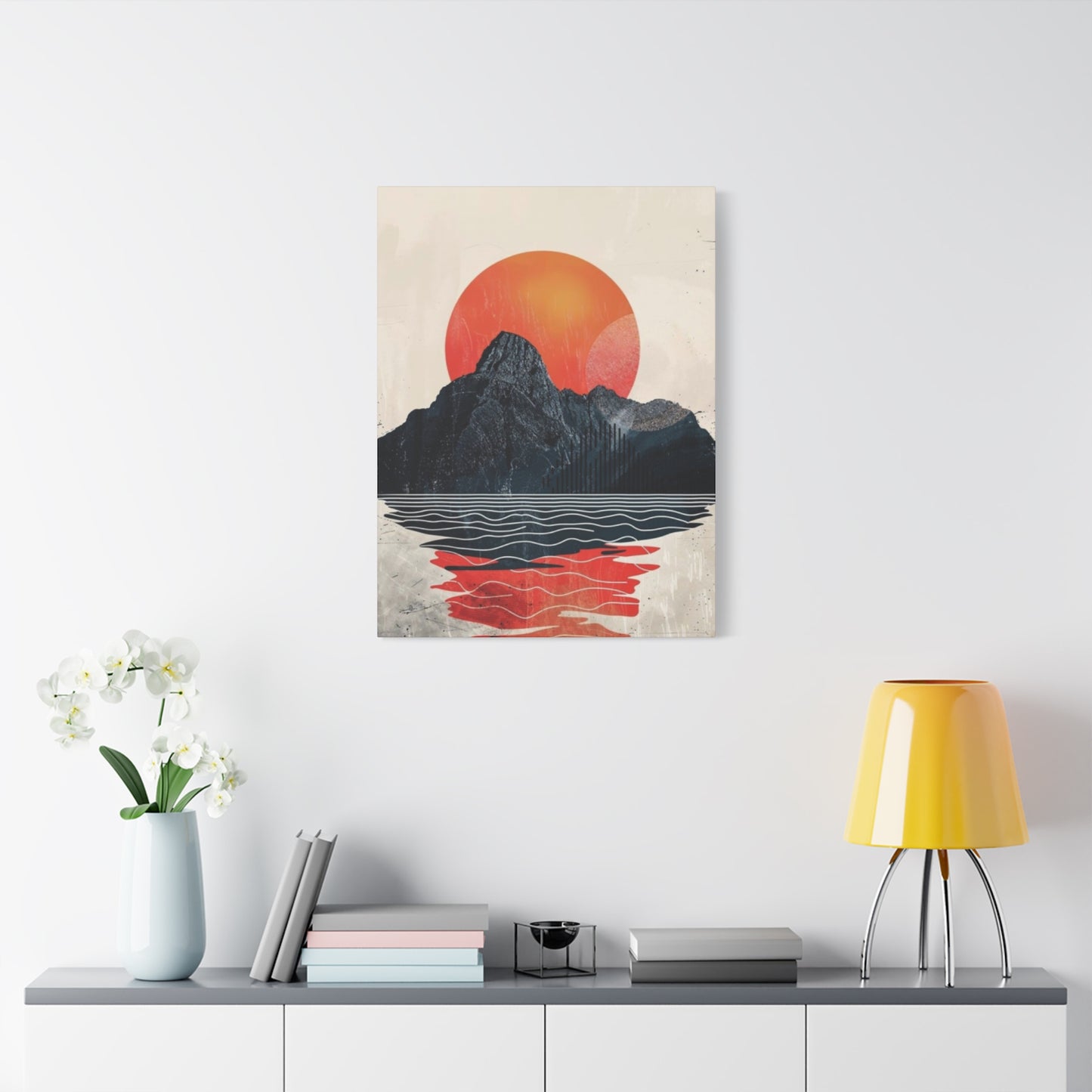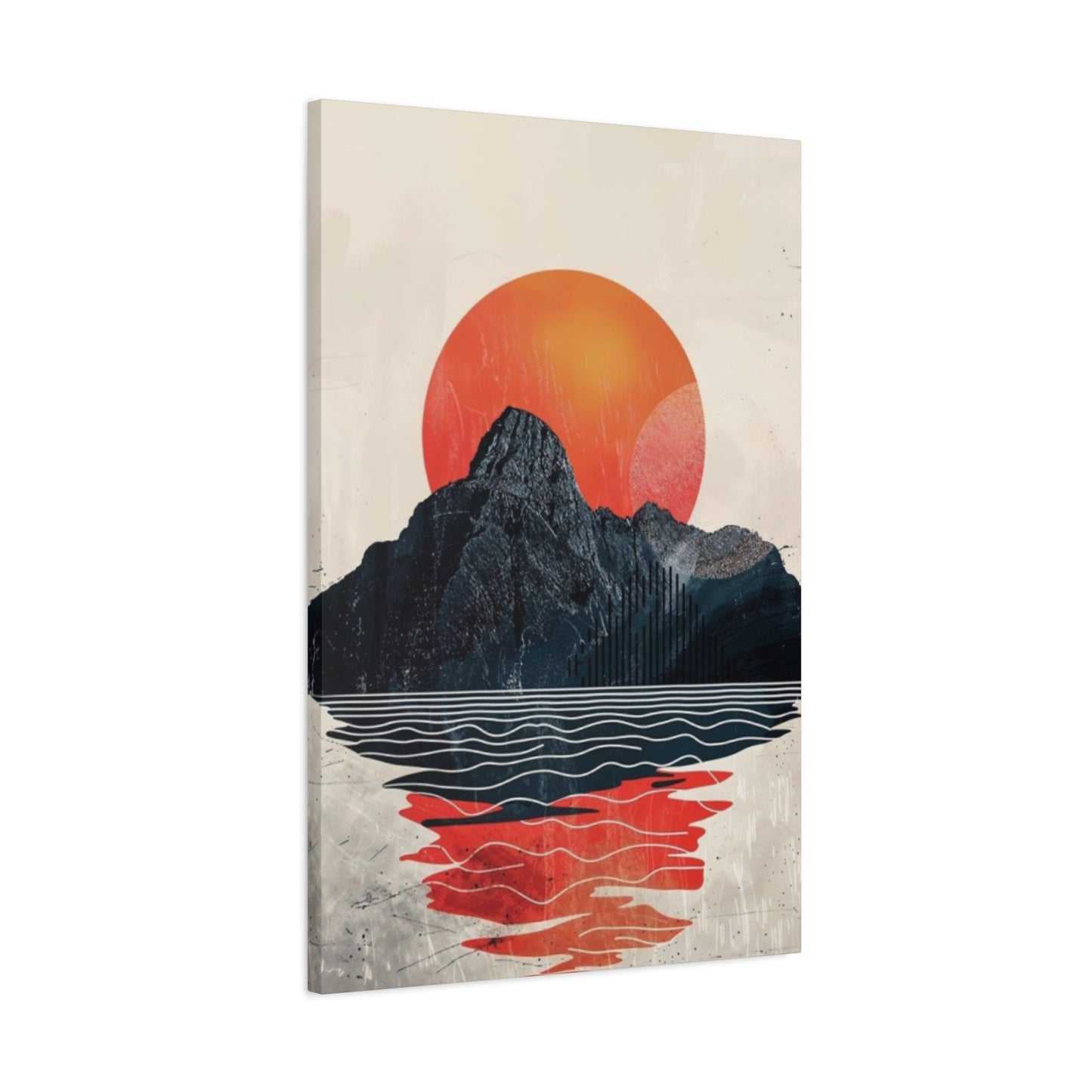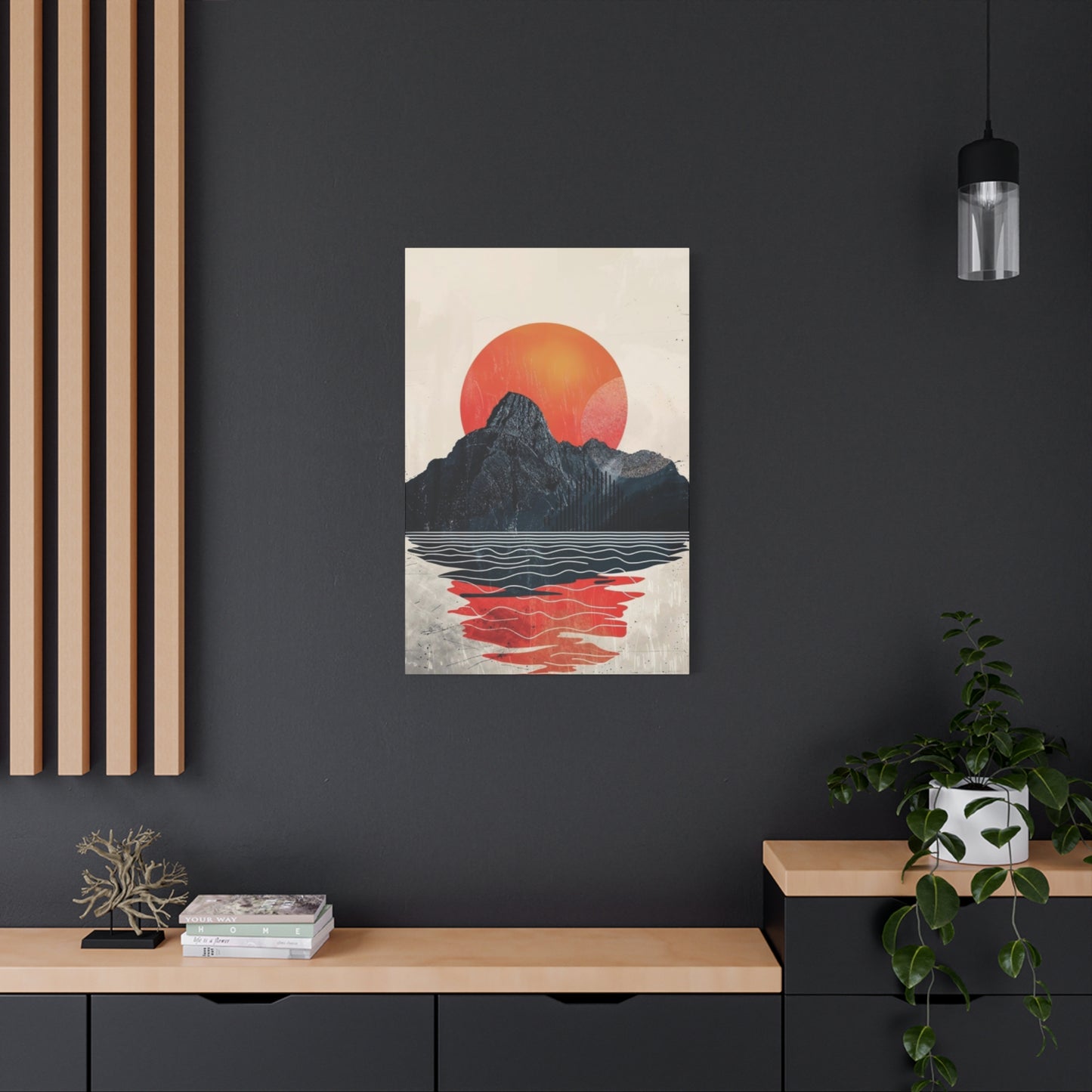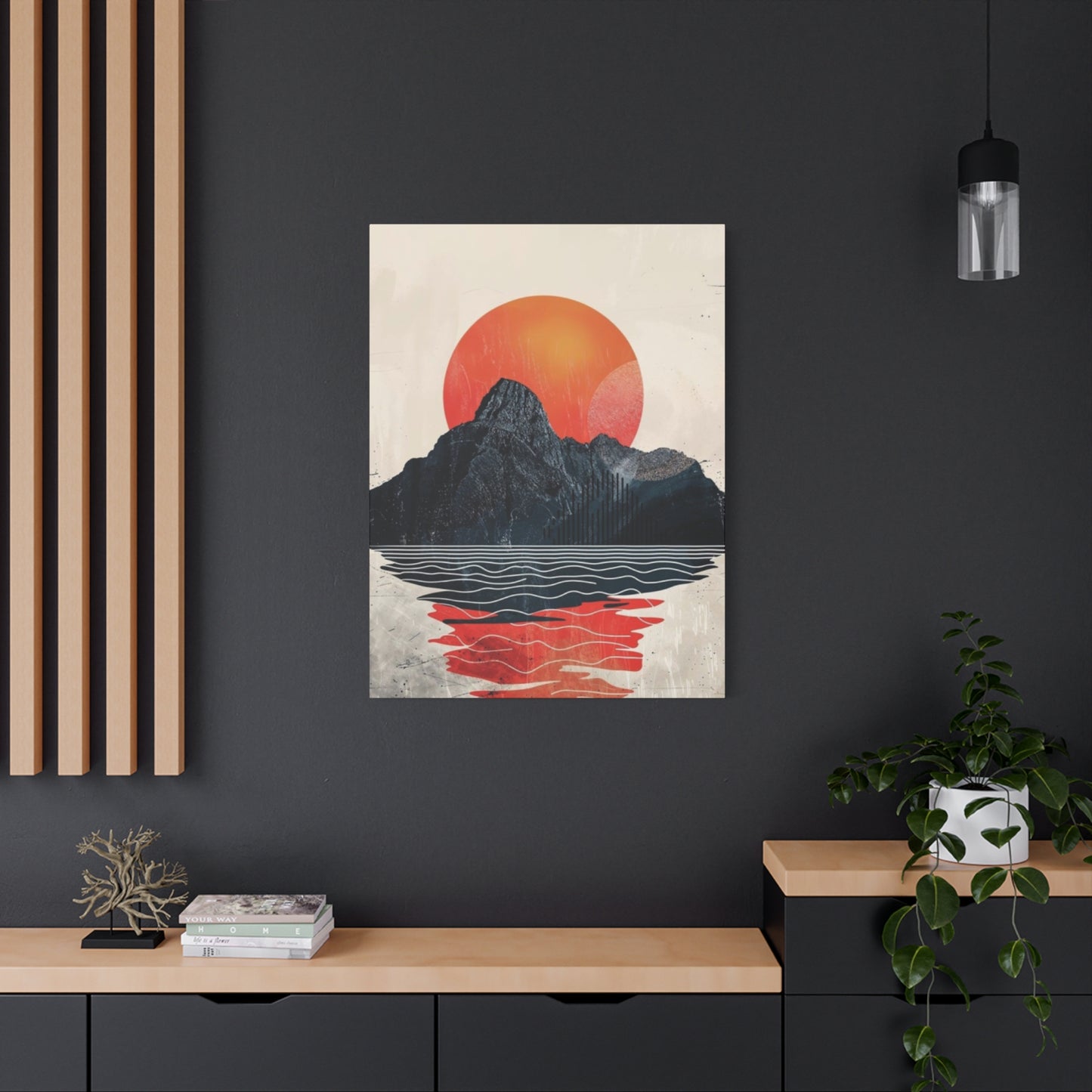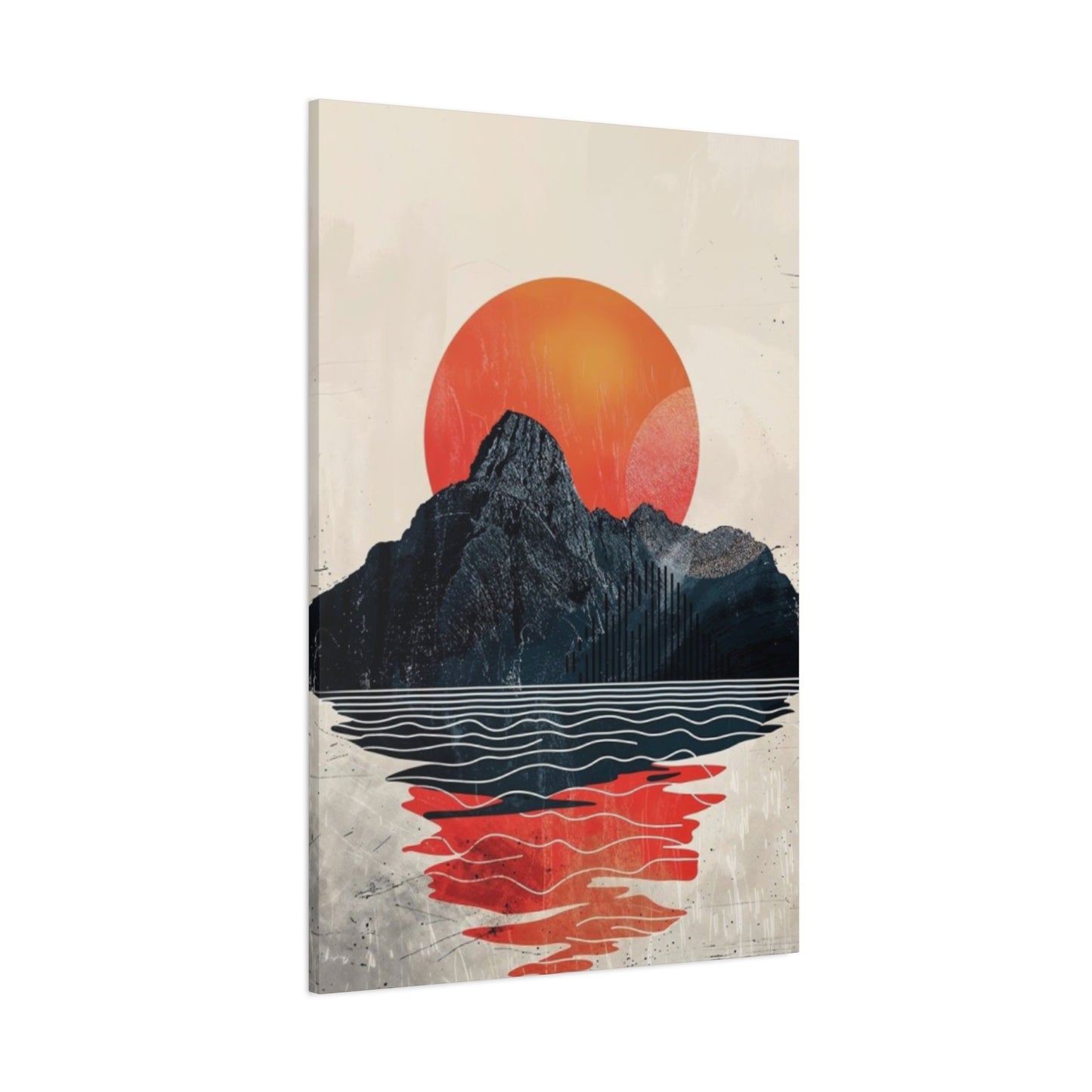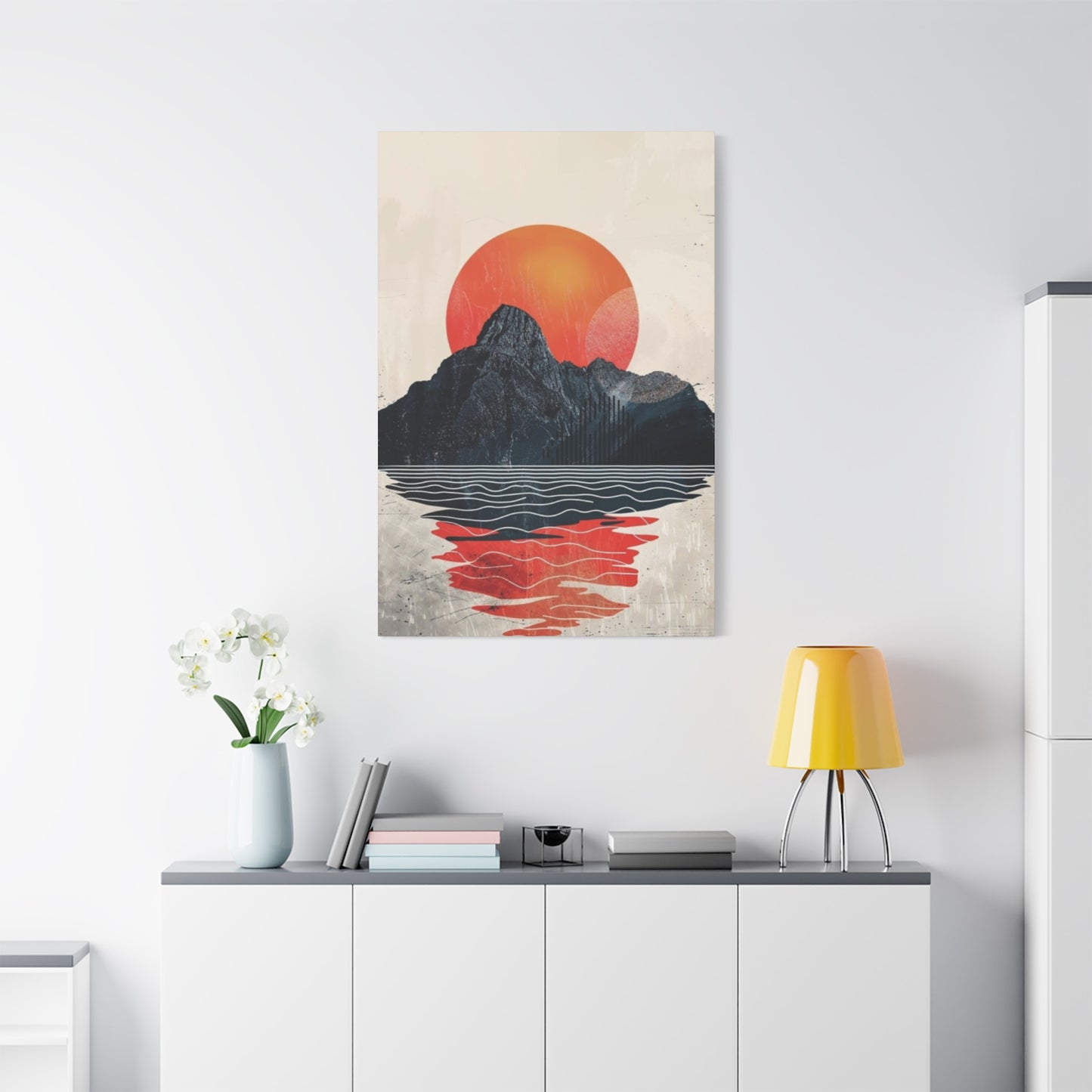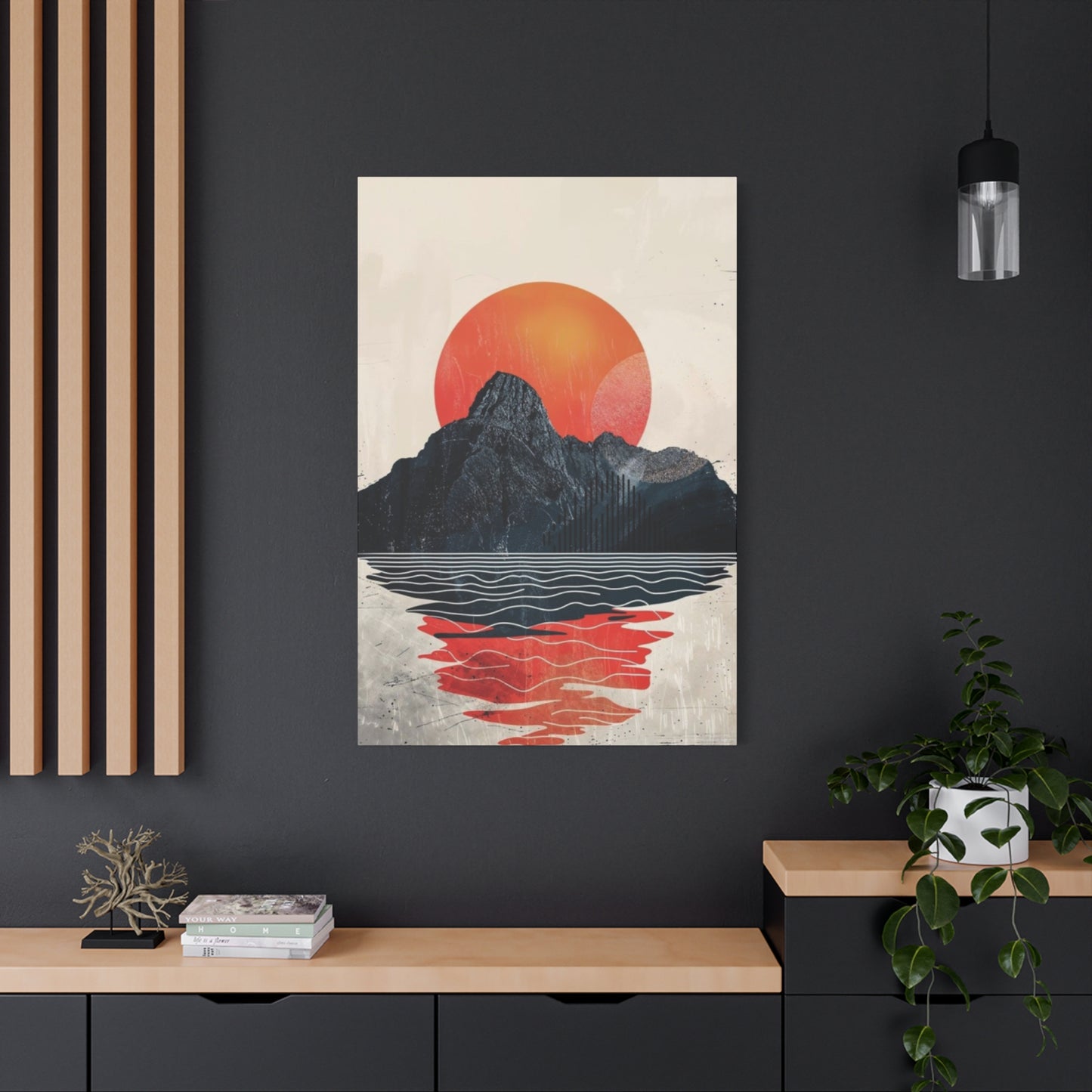Sunset in Mountains Modernism Wall Art: Transforming Your Space with Contemporary Design
Mountain sunset artwork has emerged as one of the most captivating forms of contemporary wall decoration, merging natural beauty with modernist principles to create visually stunning pieces. These artworks capture the fleeting moments when daylight transitions into twilight, painting mountain ranges in spectacular hues of amber, crimson, violet, and gold. The appeal of such pieces extends beyond mere decoration, offering viewers a connection to nature's grandeur while maintaining the clean lines and sophisticated aesthetic that defines modernist design philosophy.
Contemporary artists have reimagined traditional landscape painting by incorporating geometric shapes, bold color blocking, and minimalist compositions that speak to today's design sensibilities. The modernist approach strips away unnecessary details, focusing instead on essential forms and powerful color relationships. This creates artwork that feels both timeless and distinctly contemporary, capable of complementing various interior styles from mid-century modern to Scandinavian minimalism.
The fusion of natural imagery with modernist techniques results in pieces that serve as focal points in any room. These artworks command attention without overwhelming the space, providing visual interest while maintaining harmony with surrounding decor. Whether rendered through digital illustration, screen printing, or traditional painting techniques adapted for contemporary tastes, mountain sunset art in modernist style offers homeowners and interior designers versatile options for creating impactful spaces.
The Evolution of Mountain Landscape Art Through Modernism
The representation of mountains in visual art has undergone significant transformation throughout artistic movements. Early depictions focused on realistic portrayals, with artists attempting to capture every detail of rocky surfaces, vegetation, and atmospheric conditions. The Romantic period elevated mountains to symbols of sublime nature, emphasizing their power to inspire awe and contemplation. However, the advent of modernism revolutionized how artists approached landscape subjects.
Modernist principles encouraged artists to move beyond literal representation toward abstraction and stylization. This shift meant that mountain landscapes could be reduced to their essential geometric forms – triangular peaks, curved valleys, horizontal planes – while colors could be intensified or simplified to create emotional impact rather than photographic accuracy. The sunset element added another layer of possibility, as the dramatic lighting of dusk naturally creates bold contrasts and vivid color gradients that align perfectly with modernist sensibilities.
Throughout the twentieth century, various movements within modernism contributed to evolving mountain sunset representations. Cubists fractured landscapes into multiple perspectives, expressionists used color to convey emotion rather than reality, and minimalists reduced scenes to their most fundamental elements. Each approach influenced contemporary artists working today, who draw from this rich heritage while incorporating digital tools and printing technologies that allow for unprecedented precision and color vibrancy.
The contemporary mountain sunset aesthetic we recognize today represents a synthesis of these influences. Artists balance abstraction with recognizability, ensuring viewers can identify the subject while appreciating the artistic interpretation. This balance makes such artwork accessible to diverse audiences while maintaining artistic sophistication that appeals to collectors and design professionals.
Color Theory in Sunset Mountain Artwork
Color selection forms the foundation of impactful sunset mountain artwork, with artists carefully orchestrating hues to evoke specific moods and create visual harmony. Sunset palettes naturally incorporate warm tones – oranges, reds, yellows, and pinks – that advance toward the viewer, creating depth and immediacy. These warm colors contrast beautifully with cool tones like purples, blues, and teals that recede, establishing atmospheric perspective that suggests distance and space.
The interplay between warm and cool colors in sunset scenes creates dynamic tension that energizes compositions. Artists working in modernist styles often exaggerate these color relationships, pushing saturation levels beyond what occurs naturally to achieve maximum visual impact. This heightened color approach aligns with modernist goals of creating art that transforms spaces and affects viewers emotionally rather than merely documenting reality.
Complementary color schemes frequently appear in sunset mountain art, with orange skies contrasting against blue mountain silhouettes or violet peaks set against golden horizons. These combinations create vibration at color boundaries, drawing the eye and maintaining viewer interest. Analogous color schemes, using adjacent hues like orange, red, and pink, produce harmonious effects that feel cohesive and calming despite the intensity of individual colors.
Contemporary artists also explore unconventional color choices that depart from naturalistic palettes. Mountains rendered in unexpected hues like magenta, turquoise, or chartreuse challenge viewer expectations while maintaining compositional strength. These bold color decisions reflect modernist freedom from representational constraints, allowing artists to prioritize aesthetic considerations over accurate depiction. The result is artwork that feels fresh and innovative while remaining grounded in the recognizable imagery of mountains at sunset.
Geometric Simplification in Modernist Mountain Scenes
Modernist mountain artwork distinguishes itself through geometric simplification, reducing complex natural forms to clean shapes that emphasize structure over detail. This approach transforms jagged peaks into triangular forms, rolling foothills into curved arcs, and distant ranges into horizontal bands of color. The simplification process requires artists to identify the essential character of mountains, distilling their essence into forms that remain recognizable while achieving visual clarity.
This geometric treatment creates several advantages for contemporary interiors. Simplified forms read clearly from a distance, making such artwork effective in large spaces where intricate details would be lost. The clean shapes complement modern architecture and furnishings characterized by straight lines and minimal ornamentation. Additionally, geometric compositions create a sense of order and calm that counterbalances the visual complexity often present in contemporary living spaces filled with technology and varied objects.
Artists employ various geometric strategies when depicting mountain sunsets. Some use sharp, angular forms that emphasize the dramatic nature of mountain terrain, creating compositions with strong diagonal lines that lead the eye through the piece. Others favor softer, rounded shapes that evoke gentler landscapes and create more peaceful atmospheres. The choice between angular and curved geometry significantly impacts the emotional tone of the finished work.
Layering geometric forms creates depth in modernist mountain scenes. Artists stack simplified mountain shapes, each rendered in slightly different tones to suggest atmospheric perspective. The foreground might feature darker, more saturated colors while distant ranges fade to lighter, grayer hues. This layering technique, borrowed from traditional landscape painting but executed with geometric precision, produces convincing spatial depth despite the stylized treatment of forms.
The Role of Negative Space in Contemporary Mountain Art
Negative space plays a crucial role in modernist mountain sunset artwork, providing visual breathing room that prevents compositions from feeling cluttered or overwhelming. In this context, negative space typically manifests as expanses of sky, whether rendered in gradient sunset colors or as solid blocks of single hues. These open areas balance the solidity of mountain forms, creating compositional equilibrium that feels intentional and considered.
Effective use of negative space demonstrates artistic restraint, a valued quality in modernist aesthetics. Rather than filling every inch of canvas or paper with visual information, artists allow empty areas to exist, trusting viewers to find these spaces as meaningful as rendered forms. This approach aligns with minimalist principles that celebrate reduction and economy of means, where what is left out proves as important as what is included.
The proportion of negative space to positive forms significantly affects artwork's visual weight and mood. Compositions dominated by sky with minimal mountain forms feel expansive and open, evoking feelings of freedom and possibility. Conversely, compositions where mountains occupy most of the picture plane with limited sky visible create feelings of enclosure and intimacy. Artists manipulate these proportions intentionally to achieve desired emotional effects.
Negative space also functions as a framing device, directing viewer attention to specific areas within compositions. A large expanse of plain sky naturally draws the eye downward to where mountains break the horizon, creating a clear focal point. This visual guidance helps viewers navigate artwork intuitively, understanding relationships between elements without requiring detailed analysis. The simplicity of such compositions makes them particularly suitable for spaces where art should enhance rather than dominate the environment.
Material Choices for Mountain Sunset Wall Art
The physical materials used to create and present mountain sunset artwork significantly impact its appearance and longevity. Contemporary artists and manufacturers employ various substrates, from traditional stretched canvas to innovative materials like metal prints and acrylic mounting. Each material choice offers distinct visual characteristics and practical considerations that influence final presentation.
Canvas remains popular for its traditional association with fine art and its textured surface that adds depth to printed or painted images. Gallery-wrapped canvas, where the image extends around frame edges, creates a contemporary look that eliminates the need for additional framing. The slight texture of canvas softens digital prints, making them feel more organic and handcrafted. However, canvas requires careful handling and may need periodic cleaning to maintain appearance over time.
Metal prints represent a modern alternative that produces vivid, luminous results particularly suited to sunset imagery. The printing process infuses dyes directly into specially coated aluminum, creating images that appear to glow with internal light. This luminosity enhances the warm colors typical of sunset scenes, making them appear more vibrant than possible with other materials. Metal prints resist fading and moisture, making them practical for various environments including spaces with high humidity or direct sunlight exposure.
Acrylic mounting involves printing images on high-quality paper then mounting them behind clear acrylic panels. This creates depth and dimension, as the acrylic adds approximately a quarter inch of space between the print surface and outer surface. The effect creates subtle parallax as viewers move past the artwork, adding visual interest. The glossy surface of acrylic enhances color saturation and creates reflections that change as lighting conditions shift throughout the day.
Paper prints framed behind glass offer flexibility and affordability, allowing collectors to start with quality reproductions that can be easily updated or rotated. Museum-quality archival papers resist yellowing and degradation, ensuring prints maintain their appearance for decades when properly displayed. Various paper textures, from smooth fine art papers to heavily textured watercolor papers, affect how ink sits on the surface and how light interacts with the finished print.
Size Considerations for Mountain Artwork in Different Spaces
Selecting appropriate artwork size proves crucial for achieving desired visual impact while maintaining proper scale relationships within rooms. Mountain sunset pieces, with their horizontal orientation mimicking actual horizons, work particularly well as statement pieces in living rooms, bedrooms, and office spaces. However, the specific dimensions should relate to both wall size and furniture arrangements to create cohesive compositions.
For spaces above sofas or beds, designers typically recommend artwork spanning roughly two-thirds to three-quarters of the furniture width below. This proportion creates visual connection between furniture and wall art without either element overwhelming the other. In a living room with an eight-foot sofa, for example, a piece measuring five to six feet wide would establish appropriate scale. Hanging height matters equally, with the center of artwork typically positioned at eye level, approximately 57 to 60 inches from the floor, though this may adjust based on ceiling height and viewing circumstances.
Large-scale mountain sunset art makes powerful statements in open-concept spaces or rooms with high ceilings. Oversized pieces, six feet or wider, command attention and can anchor entire seating areas or define zones within larger rooms. The expansive format allows viewers to appreciate color gradients and subtle tonal shifts that might be lost at smaller scales. However, such pieces require adequate viewing distance – at least one and a half times the artwork's width – to be appreciated properly without feeling overwhelming.
Smaller mountain sunset pieces work beautifully in intimate spaces like home offices, reading nooks, or hallways. Pieces ranging from 16 by 20 inches to 24 by 36 inches provide visual interest without dominating compact areas. Multiple smaller pieces can be arranged in gallery walls, combining mountain sunset themes with complementary subjects to create layered, curated displays that reflect personal interests and aesthetic sensibilities.
Vertical orientations of mountain scenes, while less common, suit narrow wall spaces like those flanking windows or doors. These compositions often emphasize dramatic vertical relief in mountain terrain or exaggerate atmospheric effects with expansive skies above mountain forms. The vertical format creates upward visual movement that can make rooms feel taller, an especially valuable effect in spaces with standard eight-foot ceilings.
Incorporating Mountain Sunset Art in Various Interior Styles
Mountain sunset artwork demonstrates remarkable versatility, complementing numerous interior design styles through thoughtful selection and placement. In mid-century modern interiors characterized by clean lines, organic forms, and warm wood tones, sunset mountain art feels right at home. The period's embrace of nature-inspired design and bold colors aligns perfectly with vibrant sunset palettes, while geometric simplification echoes the era's preference for uncluttered aesthetics. Pairing such artwork with iconic mid-century furniture pieces creates cohesive spaces that honor design heritage while feeling current and livable.
Scandinavian interiors, known for their minimalism, neutral color schemes, and emphasis on natural light, benefit from carefully chosen mountain sunset pieces. Here, artists might favor muted sunset palettes with soft pinks, gentle oranges, and cool grays that complement rather than compete with the restrained color approach typical of Nordic design. The artwork adds warmth to spaces that might otherwise feel stark, introducing visual interest without disrupting the serene atmosphere Scandinavian style cultivates.
Industrial-style spaces featuring exposed brick, metal accents, and reclaimed wood gain softness and warmth through mountain sunset artwork. The organic subject matter and vibrant colors provide contrast against hard industrial materials, creating balance between rough and refined elements. Metal prints particularly suit industrial aesthetics, as the medium itself echoes the material palette while the image content introduces natural beauty that humanizes utilitarian architectural features.
Contemporary minimalist interiors require careful artwork selection to maintain the style's emphasis on essential elements and uncluttered spaces. Mountain sunset pieces succeeding in these contexts typically feature simple compositions with limited color palettes and substantial negative space. A single mountain silhouette against a gradient sunset sky, for instance, provides visual interest while respecting minimalist principles of reduction and restraint. The artwork becomes a curated focal point rather than decorative abundance.
Traditional interiors might seem challenging contexts for modernist mountain sunset art, yet thoughtful integration proves entirely possible. Choosing pieces with colors echoing traditional palettes – deep burgundies, forest greens, rich golds – helps artwork harmonize with classic furnishings and architectural details. Ornate framing can bridge stylistic gaps, dressing contemporary artwork in traditional presentation that respects the room's overall character while introducing fresh visual elements.
The Symbolism of Mountains in Contemporary Art
Mountains carry profound symbolic weight across cultures and artistic traditions, representing concepts ranging from permanence and stability to aspiration and spiritual transcendence. Contemporary artists working with mountain imagery tap into this rich symbolic vocabulary, whether consciously incorporating traditional meanings or simply recognizing mountains' inherent visual power. This symbolic depth adds layers of meaning to mountain sunset artwork, allowing pieces to resonate with viewers beyond pure aesthetic appreciation.
The mountain as metaphor for obstacles and achievement permeates contemporary culture, appearing in motivational contexts and personal development discourse. Artwork featuring mountains ascending toward radiant skies can symbolize overcoming challenges or reaching aspirational goals. This interpretation makes such pieces particularly meaningful in office settings or personal spaces dedicated to focused work, where visual reminders of perseverance and achievement support productive mindsets.
Mountains also symbolize nature's permanence and the passage of time. Their ancient geological origins and slow transformation across millennia contrast with human timescales, offering perspective on life's daily concerns. Sunset imagery reinforces temporal themes, capturing transition moments between day and night, activity and rest. Together, mountains and sunsets create meditations on time's passage, change, and continuity – themes with universal human relevance.
Spiritual and contemplative associations with mountains appear across religious and philosophical traditions. Mountains serve as places of retreat, meditation, and revelation in narratives from Moses receiving commandments to Buddhist monasteries perched on Himalayan slopes. Contemporary mountain sunset artwork, even when created without explicit spiritual intent, can evoke these associations, providing viewers with visual anchors for contemplation and reflection. The artwork becomes a window to interior spaces as much as depictions of exterior landscapes.
For many contemporary viewers, mountains represent escape from urban density and technological saturation. Mountain sunset imagery offers visual respite, connecting occupants to natural world even within city apartments or office buildings. This connection proves increasingly valued as populations concentrate in urban areas and direct nature contact becomes less routine. Artwork serves as surrogate nature experience, providing psychological benefits associated with natural environments within built spaces where such access is limited.
Digital Creation Methods for Modern Mountain Art
Contemporary mountain sunset artwork increasingly originates in digital environments, with artists employing various software applications and techniques to create pieces later output as physical prints. Digital creation offers distinct advantages including unlimited color palettes, easy experimentation, perfect reproducibility, and non-destructive editing that allows endless refinement without compromising original work. These capabilities have democratized art creation while enabling new aesthetic possibilities impossible with traditional media alone.
Vector graphics software allows artists to create mountain sunset scenes using mathematically defined curves and shapes that remain crisp at any scale. This approach suits geometric modernist styles, as artists construct compositions from precise shapes assembled like digital collage. The resulting files can be scaled infinitely without quality loss, making them ideal for producing prints ranging from small desk art to wall-sized installations. The clean edges and flat color areas characteristic of vector work align perfectly with modernist aesthetic principles.
Raster graphics applications offer different strengths, particularly for creating painterly effects and subtle color gradients that mimic traditional media. Artists can build mountain sunset scenes through layered brushwork, applying digital paint with pressure-sensitive tablets that respond to hand movements much like traditional brushes. Sophisticated blending modes allow colors to interact in complex ways, creating atmospheric effects and luminous qualities that enhance sunset imagery. The ability to work in layers enables artists to develop compositions incrementally, adjusting elements independently without affecting others.
Three-dimensional modeling software provides yet another approach, with artists constructing geometric mountain forms in virtual space then applying materials and lighting that simulate sunset conditions. Rendering engines calculate how light would interact with modeled surfaces, producing images with realistic shadows and highlights. These rendered scenes can then be stylized through post-processing to achieve desired aesthetic effects, combining spatial convincingness with artistic interpretation.
Hybrid workflows combining traditional and digital methods represent common contemporary practice. An artist might begin with hand-painted or drawn elements, scanning them into digital format for assembly, enhancement, and finishing. This approach retains the organic qualities and subtle imperfections of handwork while gaining digital advantages like easy color adjustment and perfect reproduction. The result bridges traditional and contemporary methods, appealing to audiences valuing both handcraft authenticity and modern precision.
Printing Technologies for High-Quality Mountain Art Reproductions
The journey from digital file to physical artwork involves sophisticated printing technologies that determine final appearance, longevity, and value. Giclée printing, the fine art standard, uses archival inks and high-resolution inkjet printers to produce gallery-quality reproductions virtually indistinguishable from original paintings. The term giclée, French for "spray," refers to the precisely controlled ink application that creates smooth gradients and accurate color matching crucial for sunset imagery with its subtle tonal shifts.
Giclée printers utilize twelve or more individual ink cartridges rather than the four colors in consumer printers. This expanded color gamut allows more accurate reproduction of subtle hues and creates smoother transitions in gradient areas. Archival pigment inks resist fading from UV exposure and atmospheric conditions, with properly displayed prints maintaining appearance for 100 years or more. This longevity matters for collectors and homeowners investing in artwork expected to remain vibrant across decades.
Dye-sublimation printing creates the vivid metal prints favored for contemporary mountain sunset art. This process transfers dye onto specially coated aluminum sheets using heat, with the dye actually infusing into the coating rather than sitting on the surface. The result exhibits exceptional color depth and luminosity, as light reflects off the metal backing through the semi-transparent dye layer. The waterproof, scratch-resistant surface requires no additional framing or protection, making metal prints low-maintenance options for busy households.
Direct-to-substrate printing enables artwork reproduction on various materials including wood panels, acrylic sheets, and fabric. UV-cured inks bond directly to these surfaces, creating durable prints suitable for diverse display conditions. Wood prints offer rustic charm that can enhance certain mountain sunset imagery, while acrylic prints provide contemporary glossy finishes with depth and dimension. Each substrate contributes unique characteristics that affect overall presentation and should be selected based on desired aesthetic outcome.
Color management throughout the printing process ensures that physical prints accurately reflect artist intentions. Calibrated monitors, color-managed workflows, and ICC profiles coordinate how colors display on screen and reproduce in print. This technical coordination proves essential for sunset imagery where slight color shifts can dramatically alter mood and impact. Professional print services maintain rigorous color management protocols, producing consistent results that honor original artwork.
Framing Options That Enhance Modernist Mountain Art
Framing decisions significantly impact how mountain sunset artwork presents and integrates with interior spaces. Modernist pieces often benefit from minimal framing approaches that avoid distracting from the artwork itself while providing necessary protection and visual completion. Understanding various framing styles and their effects helps collectors and designers make choices supporting artistic vision and interior design goals.
Floating frames create the illusion that artwork hovers within the frame, with a small gap between the image edge and inner frame edge. This contemporary presentation suits modernist mountain art beautifully, emphasizing the artwork as an object while maintaining clean, uncluttered appearance. The floating effect adds subtle dimensionality, casting small shadows that change as lighting shifts throughout the day. Frames in black, white, or natural wood tones complement most color palettes while maintaining focus on the artwork.
Gallery-style framing with wide mats creates breathing room around artwork, preventing visual crowding that can occur when images extend to frame edges. The mat, typically white or off-white, provides neutral transition between artwork and frame. Mat width should relate to artwork size, with larger pieces accommodating wider mats that establish formal, museum-like presentation. This approach suits smaller mountain sunset prints, giving them presence comparable to larger unmatted pieces.
Metal frames offer industrial elegance appropriate for contemporary interiors and modernist artwork. Their thin profiles create minimal visual weight while providing structural support and protection. Finishes ranging from brushed aluminum to powder-coated black or gold provide options coordinating with room hardware and decor accents. Metal frames particularly complement metal print substrates, creating cohesive presentation where frame and artwork material relate harmoniously.
Wood frames in light or medium tones introduce warmth and organic material that echoes the natural content of mountain sunset imagery. The wood grain adds subtle texture and visual interest while maintaining the simplicity modernist aesthetics require. Maple, oak, and walnut frames offer distinct color temperatures that can be selected to harmonize with existing wood tones in furniture and flooring. Simple, square-profiled wood frames feel more contemporary than ornate moldings with decorative details.
Frameless presentation, where prints mount directly to walls or display on easels without surrounding borders, creates maximum contemporary impact. This approach requires high-quality edge finishing, with canvas gallery-wrapped around frame bars or prints mounted to rigid backing with clean edges. The absence of framing eliminates any barrier between viewer and artwork, creating immediate, intimate connection. However, this approach offers less protection than framed alternatives and may suit temporary displays rather than permanent installations.
Creating Gallery Walls with Mountain Sunset Artwork
Gallery walls transform blank expanses into curated displays that reflect personal taste and create visual interest through artfully arranged collections. Incorporating mountain sunset artwork into gallery walls requires attention to composition, spacing, and thematic coherence to achieve professional-looking results that enhance rather than overwhelm spaces.
Thematic consistency helps gallery walls feel intentional rather than random. A collection entirely devoted to mountain sunset imagery in various styles, sizes, and orientations creates strong impact through repetition with variation. This approach allows exploration of a beloved theme from multiple perspectives while maintaining clear visual identity. Alternatively, mountain sunset pieces can anchor mixed galleries, providing recognizable subject matter that grounds more abstract or varied works.
Color coordination across gallery wall pieces ensures visual harmony even when including diverse subjects and styles. Selecting works sharing key colors – perhaps various artworks all incorporating sunset oranges and twilight blues – creates subtle connections that unify the display. This doesn't require identical color palettes; rather, repeated accent colors appearing in different contexts establish rhythm and relationship between individual pieces.
Size variation adds visual interest to gallery walls, preventing the monotony of identically sized frames. A common approach places the largest piece slightly off-center, with smaller works arranged around it in balanced asymmetry. This creates a focal point while allowing the eye to explore the entire composition. Ensuring adequate spacing between pieces – typically two to three inches – prevents the wall from feeling cluttered while maintaining enough proximity that pieces relate as a unified group.
Alignment strategies help gallery walls feel organized despite multiple elements. One approach aligns all bottom edges at the same height, creating strong horizontal line that grounds the display. Another aligns centers vertically or horizontally, allowing varied sizes while maintaining geometric order. Grid arrangements, with pieces aligned both horizontally and vertically, create formal, structured appearances suited to contemporary interiors. Salon-style arrangements, where pieces of varied sizes nestle together with minimal gaps, create energetic, collected-over-time aesthetics.
Layout planning before installation prevents wall damage from repositioning. Creating paper templates the exact size of each frame and arranging them on the wall with removable tape allows experimentation without commitment. Alternatively, arranging all pieces on the floor in planned configuration and photographing the result provides reference during installation. Many find it helpful to start from the center and work outward, or to install the largest piece first and arrange smaller works around it.
The Influence of Japanese Aesthetics on Modern Mountain Art
Japanese artistic traditions have profoundly influenced contemporary Western approaches to landscape art, including modernist mountain sunset imagery. Concepts drawn from Japanese philosophy and visual culture inform compositional choices, color applications, and aesthetic goals that define much contemporary mountain artwork.
Ma, the Japanese concept of negative space and intervals, appears prominently in modernist mountain compositions. Rather than viewing empty areas as unused space, ma recognizes them as active elements carrying meaning and energy. In mountain sunset artwork, expansive skies embody ma, creating pause and breathing room that allows viewers to contemplate what is shown while imagining what is suggested beyond frame edges. This intentional emptiness creates balance and prevents visual overcrowding.
Wabi-sabi, the aesthetic philosophy embracing imperfection and transience, influences how contemporary artists approach mountain subjects. Rather than seeking perfect geometric precision, artists might incorporate subtle irregularities and organic variations that acknowledge handmade origins even in digitally created work. The sunset's fleeting nature – that specific configuration of light and color existing for mere minutes – embodies wabi-sabi's acceptance of impermanence. Artwork capturing this transient beauty invites reflection on change and the preciousness of momentary experiences.
Simplification and suggestion, hallmarks of Japanese ink painting, appear in modernist mountain art through reduced color palettes and minimal detail. Rather than rendering every tree and rock, artists indicate mountain character through essential forms, trusting viewers to complete the image mentally. This approach respects viewer intelligence and imagination, creating participatory viewing experiences rather than passive consumption of completely rendered scenes.
Flat picture planes and limited depth, characteristics of traditional Japanese prints, inform contemporary approaches to mountain landscapes. While Western perspective creates deep spatial recession, many modernist mountain works embrace flattened space with layered shapes establishing only modest depth. This creates graphic quality that reads clearly and suits modern design contexts where artwork functions as design element as much as pictorial window.
The influence of ukiyo-e woodblock prints specifically appears in bold outlines, flat color areas, and dramatic compositions. The graphic quality of these prints, originally a commercial art form, translates beautifully to contemporary contexts where art decorates everyday spaces rather than occupying rarified gallery environments. This democratization of art aligns with modernist goals of bringing quality design to broader audiences.
Color Gradients and Transitions in Sunset Sky Rendering
The rendering of sunset skies represents both technical challenge and creative opportunity in mountain artwork. Natural sunsets display complex color gradients where multiple hues blend seamlessly across the sky, transitioning from warm tones near the horizon to cooler colors overhead. Capturing this complexity while maintaining the clarity modernist aesthetics require demands careful consideration of color theory and technical execution.
Smooth gradient transitions separate professional-quality artwork from amateur efforts. In digital creation, artists achieve seamless blends using gradient tools with multiple color stops, carefully positioning transition points where colors shift. The eye naturally reads smooth gradations as atmospheric and spatial, creating convincing skies that suggest depth and distance. Harsh boundaries between color bands, conversely, feel artificial and disrupt the atmospheric illusion, unless used intentionally for graphic effect.
Some artists embrace banded color approaches where sunset skies divide into distinct horizontal stripes of different hues. This stylized treatment acknowledges the artificiality of art-making rather than attempting realistic atmosphere. When executed with attention to color relationships and proportional balance, banded skies create striking graphic effects that emphasize design over representation. The approach suits certain contemporary interiors where bold, simplified forms prove more effective than subtle naturalism.
Radial gradients emanating from the setting sun's position create focal points and guide viewer attention. Colors intensify near the light source, typically rendered in brilliant yellows, oranges, or pinks, before transitioning through a spectrum to cooler tones at the composition's edges. This natural visual hierarchy draws the eye to specific areas while suggesting the light source's location even when the sun itself appears outside the frame or hidden behind mountains.
Texture application within gradient skies adds visual interest and prevents flatness. Even minimal texture suggesting atmospheric particles, clouds, or digital noise creates surface activity that engages viewers and suggests natural variation. Too much texture creates busy, distracting surfaces, while completely smooth gradients can feel sterile despite technical perfection. Finding appropriate balance depends on overall aesthetic goals and the degree of stylization the artwork embraces.
Color temperature progression from warm to cool creates convincing atmospheric depth. Near the horizon, where sunset's glow concentrates, warm oranges and reds dominate. Moving upward, colors cool through purples and magentas toward blues overhead. This temperature shift mimics natural atmospheric behavior where scattered sunlight creates warm horizon colors while the sky above retains daytime's blue. Respecting this natural color behavior, even when exaggerating saturation or adjusting hues, maintains visual believability that grounds stylized artwork.
Mountain Silhouettes and Layered Forms
Mountain silhouettes provide powerful compositional devices in modernist sunset artwork, creating strong graphic elements that anchor compositions and establish spatial relationships. Rendering mountains as simplified silhouettes emphasizes form over detail, focusing viewer attention on overall shapes and their relationships rather than textural surfaces.
Layering multiple mountain ranges at different depths creates spatial recession through overlapping forms and tonal shifts. Foreground mountains typically appear darkest, rendered in deep blues, purples, or even black silhouettes. Mid-ground ranges lighten slightly, showing more color while remaining darker than background elements. Distant mountains fade to pale purples, grays, or blues, approaching the sky's value and color temperature. This progressive lightening mimics atmospheric perspective, where distance and intervening air scatter light and reduce contrast.
The profile of mountain silhouettes significantly impacts compositions. Sharp, jagged peaks create dynamic energy and dramatic tension, their irregular skylines drawing the eye along varied contours. Gentler, rolling profiles produce calmer effects, their soft curves creating rhythmic flow across compositions. Artists select or invent mountain profiles that support intended emotional tones, recognizing that form language communicates as powerfully as color.
Negative space created within mountain silhouettes – valleys, gaps between peaks, saddles between summits – adds complexity to simplified forms. These openings allow background colors and light to penetrate, creating visual interest and preventing solid, heavy appearance. The interplay between mountain mass and void spaces introduces rhythm and prevents monotony that might occur with continuous silhouetted forms.
Varying silhouette detail across different depth layers creates additional interest. Foreground mountains might show more intricate contours with smaller variations in the skyline profile, while distant ranges simplify to smooth, continuous forms. This differential detailing reinforces spatial hierarchy while providing focal areas of complexity balanced against simpler background elements.
Some artists incorporate internal detail within silhouetted mountains, adding texture, pattern, or tonal variation while maintaining overall simplified forms. This approach bridges complete silhouette and fully rendered approaches, offering visual interest without abandoning modernist simplification. The internal detail might suggest geological features, vegetation patterns, or purely decorative elements that enrich surfaces while respecting the fundamental compositional strength of silhouetted forms.
Lighting Effects in Modernist Mountain Sunset Compositions
Light behaves as both subject and tool in mountain sunset artwork, creating atmosphere while structuring compositions through value relationships and color temperature. Modernist approaches to lighting often simplify natural complexity while retaining essential character that makes sunset scenes emotionally resonant and visually compelling.
Backlighting, where the light source positions behind mountains, creates dramatic silhouettes and emphasizes form. This lighting creates strong value contrast between dark mountain shapes and luminous skies, producing graphic impact particularly suited to modernist aesthetics. The backlit approach eliminates surface detail, reducing mountains to pure form and focusing attention on overall composition rather than textural variety.
Rim lighting, where edges of forms catch light, adds dimensionality to otherwise flat silhouettes. A thin line of bright color – perhaps golden orange or warm pink – traces mountain ridgelines where the setting sun directly illuminates peaks. This subtle detail prevents complete flatness while maintaining simplified treatment. The rim lighting draws attention to mountain profiles, emphasizing their shapes against sky backgrounds.
Atmospheric glow surrounding the sun creates soft, diffused light that radiates across skies. Artists render this effect through graduated intensification of warm colors near the light source, creating radiant halos that suggest light scattering through atmosphere. This glow provides natural focal points and establishes the light source's position even when the sun itself remains outside the frame or hidden behind landscape elements.
Shadow patterns within mountain forms, though often simplified in modernist work, can suggest three-dimensional volume and surface variation. Even within generally silhouetted mountains, subtle value shifts might indicate major geological features like deep valleys or prominent ridges. These shadows remain simplified compared to realistic rendering but provide enough information to suggest mass and solidity beyond flat cutout appearance.
Reflected light in atmospheric elements – clouds catching sunset glow, sky colors reflected in mountain surfaces – creates complex color interactions that enrich compositions. Even when treating these effects in simplified, stylized ways, their inclusion adds layers of visual interest and strengthens the relationship between sky and land elements. The interplay of direct and reflected light creates harmony across compositions while providing color variation that maintains viewer engagement.
Artistic License in Modernist Mountain Representation
Modernist mountain sunset artwork embraces artistic license, prioritizing aesthetic impact over documentary accuracy. This freedom allows artists to create powerful compositions that communicate emotional and visual experiences rather than replicating specific locations or meteorological conditions. The license extends to multiple aspects of creation, from color selection to compositional arrangement.
Color manipulation represents primary area where artistic license operates. Natural sunset colors, while beautiful, may be intensified, shifted, or completely reimagined to achieve desired effects. Mountains naturally appearing brown or gray might be rendered in purples, blues, or even unexpected hues like turquoise or coral. These choices prioritize compositional harmony and emotional impact over local color accuracy. The resulting artwork feels truer to the experience of viewing sunsets – the wonder, peace, or exhilaration they inspire – than photographically accurate color reproduction might achieve.
Compositional arrangement exercises similar freedom. Mountain ranges can be compressed, expanded, or completely invented to serve aesthetic goals. Peak heights might be exaggerated for dramatic effect, or multiple actual locations combined into single imaginary landscapes that distill essential mountain character. This invented geography focuses on creating ideal compositions rather than accurately mapping real places.
Scale relationships between elements bend to artistic needs. The sun might be rendered larger than natural to increase its visual impact and compositional weight. Mountain sizes relative to each other can be adjusted to create balanced arrangements rather than respecting actual relative heights. Foreground elements might be minimized or eliminated entirely to focus attention on distant mountains and skies.
Atmospheric effects including clouds, haze, and color gradients can be exaggerated or understated based on compositional requirements. A naturally cloudy sunset might be rendered perfectly clear to simplify the composition, while a clear evening might gain dramatic cloud formations that add interest. These adjustments serve the artwork's internal needs rather than documenting specific weather conditions.
Temporal flexibility allows artists to combine effects that occur at different times or seasons into single images. The particular quality of light from a winter sunset might combine with summer's landscape characteristics, creating impossible but visually compelling syntheses. This temporal collapsing serves modernist goals of creating ideal forms rather than capturing specific moments.
Final Thoughts
The Sunset in Mountains Modernism Wall Art is more than just a piece of decor—it’s a statement, a reflection of modern artistic sensibilities combined with the timeless beauty of nature. This collection redefines how we can appreciate the natural world within the framework of contemporary design, blending the rich, dramatic colors of a sunset with the serene, majestic presence of mountains in a way that speaks to both the eye and the soul. By incorporating this artwork into your space, you're not simply filling a wall—you're transforming your environment, creating a dialogue between art, nature, and modern aesthetics.
One of the most compelling aspects of the Sunset in Mountains collection is its ability to capture the essence of nature in an abstract, yet profoundly impactful way. Modernism, with its focus on clean lines, minimalism, and simplified forms, allows the vibrant colors of the sunset and the geometric lines of the mountains to emerge with clarity and power. The warmth of the sun setting behind the cool, towering peaks creates a striking contrast that draws the viewer in, evoking feelings of both peace and awe.
For those with an appreciation for contemporary design, this artwork serves as an ideal way to incorporate nature into a modern setting. Its abstract representation of the sunset and mountains blends seamlessly with clean, minimalist interiors, making it a perfect choice for those who wish to create a balance between nature and modern design. Whether your space is a sleek urban apartment, a cozy studio, or a contemporary home, Sunset in Mountains Modernism Wall Art acts as both an anchor and a focal point, tying together various elements of the room while infusing it with color and emotion.
Beyond its visual appeal, the Sunset in Mountains series has the power to evoke emotion and memory. For many, the sight of a mountain range at sunset is not just a beautiful image, but a personal experience—whether it's a hike up the mountainside or a peaceful moment spent watching the sun dip below the horizon. This artwork invites you to relive those moments, transporting you to a place of calm, reflection, and inspiration. The dynamic interplay of warm and cool tones, paired with the abstract representation of the mountains, allows this piece to resonate on an emotional level, creating a sense of tranquility in your space.
Another remarkable feature of the Sunset in Mountains Modernism Wall Art is its versatility. It can effortlessly complement various interior design styles, whether it’s the stark minimalism of Scandinavian decor, the bold lines of industrial chic, or the rich textures of contemporary boho. The fusion of modernism and nature gives this art piece the ability to enhance any room, adding depth and dimension without overwhelming the space. The simplicity of the design allows it to blend effortlessly with existing furniture and decor, while its striking color palette ensures it remains a statement piece in any room.
Finally, incorporating Sunset in Mountains Modernism Wall Art into your home is more than just about adding a visual element; it’s about creating a space that reflects who you are and the mood you want to evoke. Whether you’re seeking a sense of calm, inspiration, or simply a reminder of the beauty of nature, this artwork serves as a reminder that even in a world dominated by modern design, nature’s beauty remains an eternal source of wonder and peace.
In conclusion, Sunset in Mountains Modernism Wall Art is the perfect fusion of contemporary design and natural beauty, offering a timeless appeal that elevates any space. It invites a sense of tranquility and reflection while seamlessly fitting into the framework of modern aesthetics. With its bold colors, minimalist style, and emotional resonance, it’s more than just a piece of art—it’s an experience, a transformative addition to your home that will continue to inspire and captivate for years to come.


















